Today we
trek from Ghorepani at 2900 meters elevation down to Ghandruk at 2000, first
climbing to a ridge at 3200 meters (10,500 feet) and then dropping very steeply
down some deep ravines. But I remember this isn’t a birding expedition, and
with a wedding band playing very out-of-tune ancient Himalayan instruments in a
nearby courtyard all night long, Andrew probably needs more sleep and a gradual
start to the day. Even I get up late and head out almost an hour after sunrise
to explore the habitats up Poon Hill.
Again, I was
grateful for Resham’s suggestion we go up Poon Hill the night before. Until I
found a nice, quiet side trail into the oak and rhododendron forest, I climbed
up only a couple hundred meters of steps toward the peak and passed maybe 75
hikers coming down from their sunrise vigil (where they saw a wall of haze and
no mountain peaks). I’m guessing 125 to 150 people must have been up there,
some of whom I recognized from our hikes the previous two days – two Swedish
girls, a group of Spaniard women, a Costa Rican traveling with a Canadian. I
chatted with two identical twin Danish boys about 12 who were near the end of
their two-week trek around the Annapurna massif.
Bird
activity was high, and I found some wonderful habitat that would surely have
something new – very mossy forest with lots of understory, including bamboo. Some
rhododendrons were in bloom at this elevation; in the previous two days at
lower elevations it was clear that we had been well past the peak.
There were
lots of singing Blyth's Leaf Warblers, and I finally managed to get a photo of
one of these super hyper wing-flickers.
White-browed
Fulvetta is a conspicuous and common member of the understory. Another of the
former babbler family, this is now at least tentatively in Paradoxornithidae,
along with the parrotbills and the Wrentit.
A small
group of Black-faced Laughingthrushes were foraging on the ground. Two of them
made a scolding chatter and moved up into the trees behind me while a third
began to sing from an exposed perch in front of me.
Bamboo here
is very different than in the Andes: the stems are thin and straight, the
plants only 3-4 meters tall, and they form large thickets of evenly-spaced
stems that you can actually see into. This patch of bamboo had a large stand of
the cobra-lily Arisaema nepenthoides.
I sat down
next to some bamboo when I heard a most remarkable song. I eventually found
that it came from a tiny, brown warbler-like bird with a warmer brown cap and
pale supercilium. It turns out to be called Hume’s Bush-Warbler, which isn’t
even in my book. It was apparently once lumped with Yellowish-bellied
Bush-Warbler (which is in the book but is now the name of the form found only
in China), but the voice described is completely wrong. I got a recording,
noted the bird’s appearance, and then had to wait for an internet connection later
in the evening to listen to songs on xeno-canto before I could put a name to
it.
A full song
lasts 24 seconds and has three very distinctive parts – pure whistles, a happy,
Ruby-crowned Kinglet-like chatter, and an insect-like clicking – that are
repeated in the same order again and again. I got one recording that has three
entire songs back-to-back. Each part is so different, it could fully stand
alone as a complete song and even be interpreted as belonging to birds in
utterly different families. It took me a while to come to terms with the entire
song; it’s not very loud, but I eventually was able to watch the bird do it.
Have a
listen to my recording here, and follow along on the sonogram that I annotated
to help separate it from the other birds in the background.
While I was
recording the bird and trying to get good looks, I had the fortune of watching
two Hill Partridges creep through the bamboo understory, a bird that is frequently
heard (at least earlier in the season) and almost never seen.
On my way
back, I noticed some motion in the bamboo and was thrilled to see two Brown
Parrotbills. They were quiet and very inconspicuous as they clung upside down
on the bamboo stems and tore into them with their strong bills. Genetic data
tells us the members of this and other similar genera in the classic
Paradoxornithidae are the closest relatives of the Wrentit. I wasn’t able to
get a photo though.
After
breakfast we finally headed out on what would be our longest day hike of the
trek. The straight-line distance wasn’t all that great (under 11 km), but there
was a lot of up-and-down. First it was up to a ridge with scattered grassy
meadows, especially on the south-facing slope. I’m guessing there’s a long
history of fires here that keep some of the hotter slopes more open. Here’s a view
back to Poon Hill.
We had fun
pishing and tooting in some very active mobs. Many contained this aberrant
chickadee, the Yellow-browed Tit.
We had more Chestnut-tailed
Minlas; this is a better photo than yesterday’s.
One doesn’t absolutely
need to hire guide if you study the route and have good maps. Signs like this
to Tadapani also help.
I thought
this looked so much like our northern fritillaries that it was certainly a Boloria, but it is actually Issoria issaea, the Queen of Spain
Fritillary.
One of the
most attractive birds of this area is the skulky Spotted Laughingthrush, which
I saw twice, both times as individuals.
Another
strange chickadee, the Gray-crested Tit, like a muted Crested Tit.
I think this
common primrose at the edge of meadows is Primula
erosa.
We topped
out at this grassy hilltop where many hikers took a long pause and bought candy
bars or chips from the little store at the top.
I got distracted from
Olive-backed Pipits and several of these Rosy Pipits.
I managed a
bad photo of this Gray-sided Bush-Warbler from the low, spiny bushes at the
edge of the meadow.
After the
grassy hill, the trail mostly passed through beautiful rhododendron forests,
where the largest and dominant trees were the rhododendrons themselves, not
just a dominant understory or even mid-story shrub.
Another bird
common in the mixed flocks and mobs here was the Rufous-vented Yuhina. Yuhinas
are now in the white-eye family, Zosteropidae.
This is a
Coal Tit, the same species that occurs in central Europe where I got to know it
well 25 years ago.
This White-collared
Blackbird is thrush, like the European Blackbird. But it sings from exposed
treetops on the ridges and has a very distinctive song of loud, simple phrases
that I found easy to imitate. It responded very aggressively to my whistles.
This is also
a thrush, Gray-winged Blackbird, and it sounds very similar to the European
Blackbird, very varied and musical, impossible to imitate, and from a hidden
perch in the dense, mid-story crowns.
Here’s a
view showing how dominant the rhododendrons are, with some bamboo in the
foreground.
One of the
most amazing birds I had in this area was a pair of Great Parrotbills, the size
of a large laughingthrush. I didn’t get a photo but was able to record the song.
After so
much whistling to bring in mobs of small birds, I finally attracted a real Collared
Owlet, in the same genus as our pygmy-owls.
This is a
male White-browed Bush-Robin, related to Red-flanked Bluetail.
After a few
kilometers, our 3200 meter-high ridge eventually gave way to some serious
topography, and we started descending rapidly. Here is a rocky cliff above the
trail where I had hoped to spot a bee hive and a Yellow-rumped Honeyguide, but
no such luck.
A few
plants: a Viola species
An unknown flower,
maybe Ranunculaceae
Very much
like our Oregon Grape, this is Mahonia (or
Berberis) napaulensis.
Fragaria sp., a strawberry.
The forests
continued to be great habitat, largely dominated by bamboo, but it was clear
that I couldn’t dawdle too much, as we still had a long ways to go.
From this
viewpoint, one would normally have a view of mountains shown in the painting.
After the
village of Tadapani, we dropped down through a deep canyon with very tall trees
and wet forest. This is a well known area for spotting Nepal Gray Langurs, and
we had a few.
I was a bit
unprepared to ID any of the possible four treecreepers in Nepal, and it didn’t
help that my out-of-date field guide had different names for half of them than
what appeared on the eBird app I was using. So I frantically snapped photos
when we had a pair. This photo does show the plain tail and poorly defined
facial outline to call it a Hodgson's Treecreeper (which is Eurasian
Treecreeper in my book).
This Snowy-browed
Flycatcher in a very dark understory was sharing habitat with a Gray-bellied
Tesia.
As we
approached Ghandruk, habitat started becoming a bit more fragmented, with the
accompanying sunlight allowing for more butterfly activity. This swallowtail is
Atrophaneura polyeuctes, the Common
Windmill.
Ghandruk is
one of the more popular trekking villages, and this hotel map shows nearly 50
places one can stay.
After over
17 kilometers of hiking we were ready for a break; Andrew is back to his usual reading material, having settled on Verditer Flycatcher as his favorite bird.



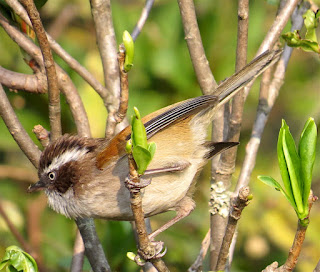
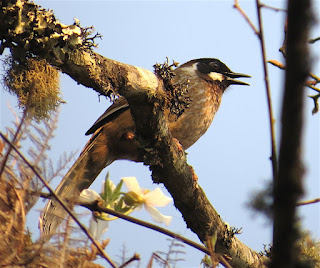



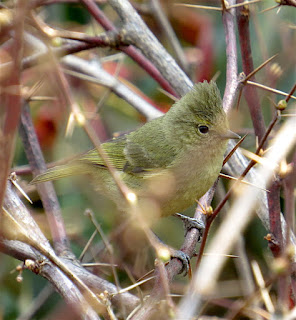






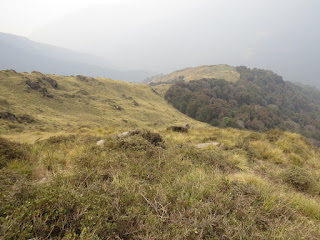

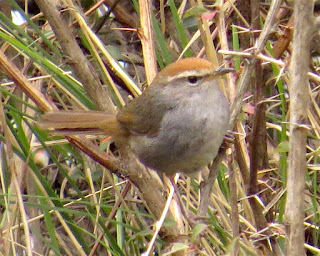



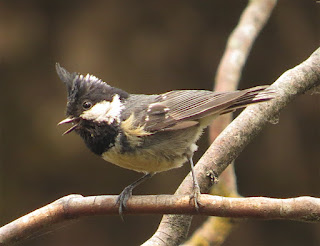






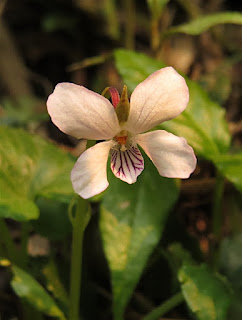


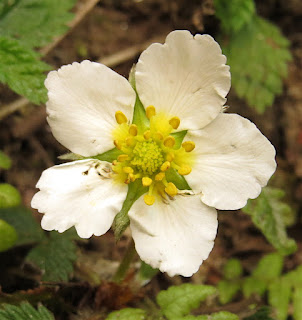













No comments:
Post a Comment